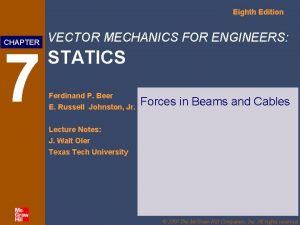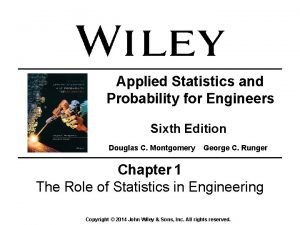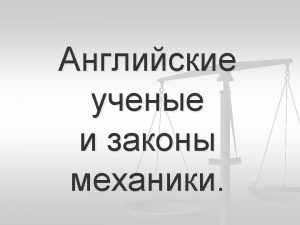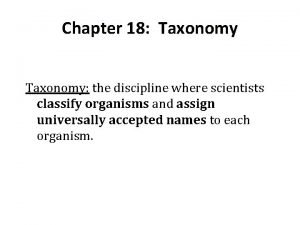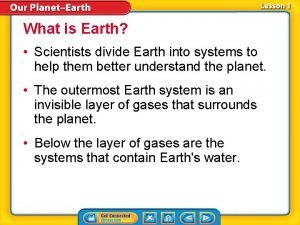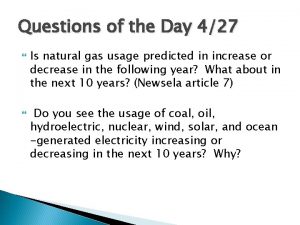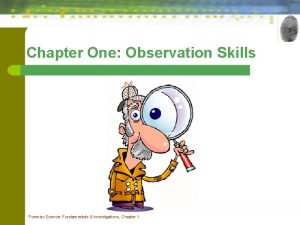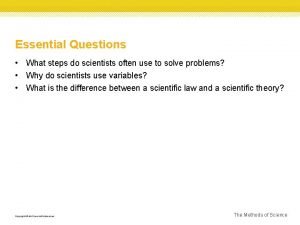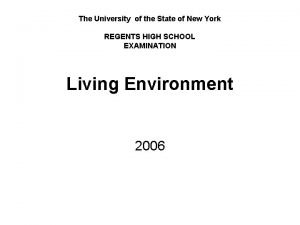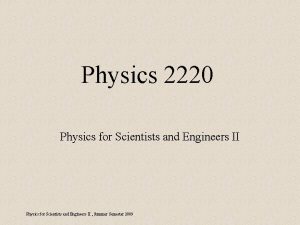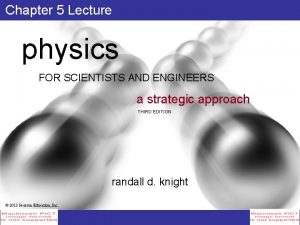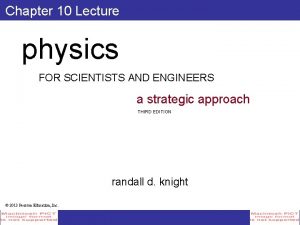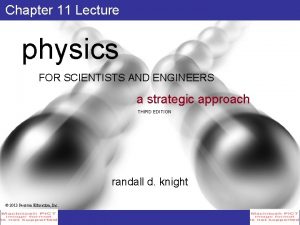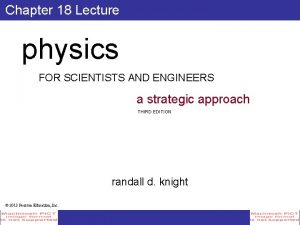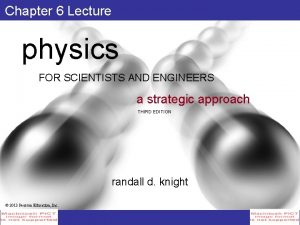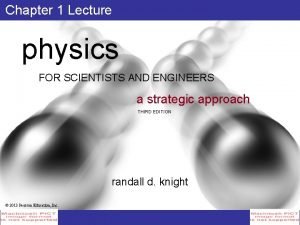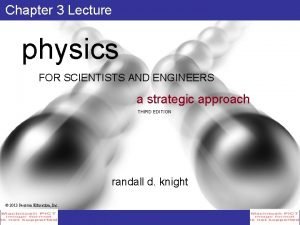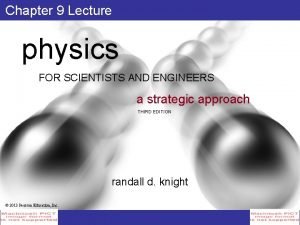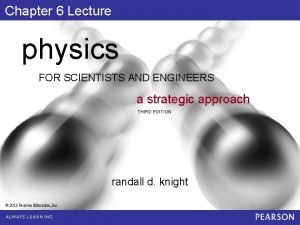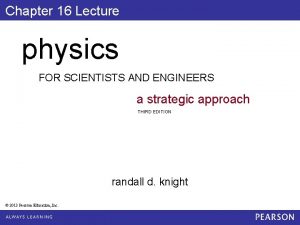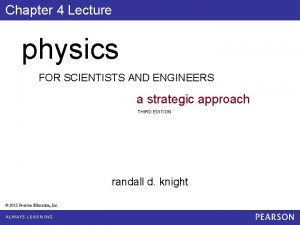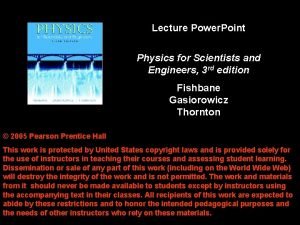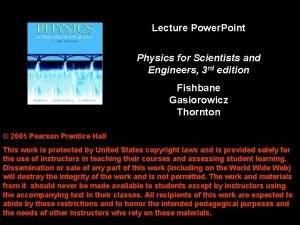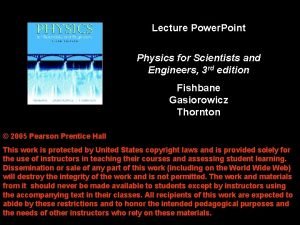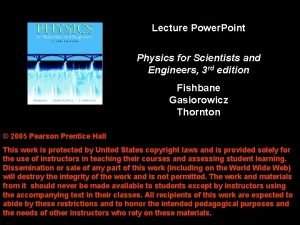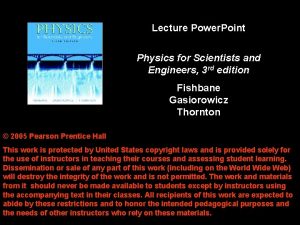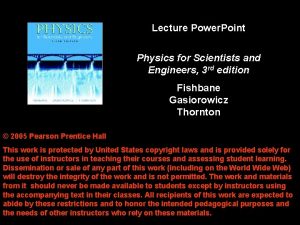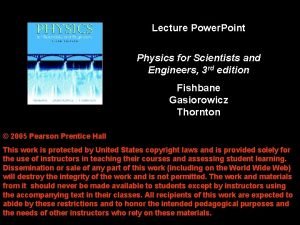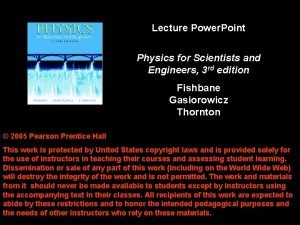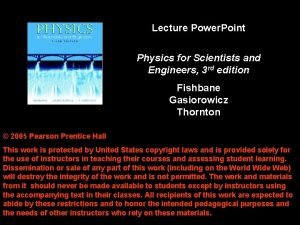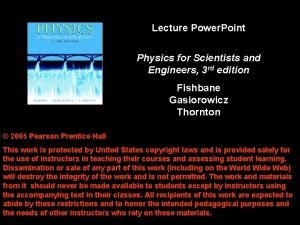Chapter 2 Lecture physics FOR SCIENTISTS AND ENGINEERS
























































































































- Slides: 120

Chapter 2 Lecture physics FOR SCIENTISTS AND ENGINEERS a strategic approach THIRD EDITION randall d. knight © 2013 Pearson Education, Inc.

Chapter 2 Kinematics in One Dimension Chapter Goal: To learn how to solve problems about motion in a straight line. © 2013 Pearson Education, Inc. Slide 2 -2

Chapter 2 Preview § Kinematics is the name for the mathematical description of motion. § This chapter deals with motion along a straight line, i. e. , runners, rockets, skiers. § The motion of an object is described by its position, velocity, and acceleration. § In one dimension, these quantities are represented by x, vx, and ax. § You learned to show these on motion diagrams in Chapter 1. © 2013 Pearson Education, Inc. Slide 2 -3

Chapter 2 Preview © 2013 Pearson Education, Inc. Slide 2 -4

Chapter 2 Preview © 2013 Pearson Education, Inc. Slide 2 -5

Chapter 2 Reading Quiz © 2013 Pearson Education, Inc. Slide 2 -6

Reading Question 2. 1 The slope at a point on a position-versus-time graph of an object is A. The object’s speed at that point. B. The object’s average velocity at that point. C. The object’s instantaneous velocity at that point. D. The object’s acceleration at that point. E. The distance traveled by the object to that point. © 2013 Pearson Education, Inc. Slide 2 -7

Reading Question 2. 1 The slope at a point on a position-versus-time graph of an object is A. The object’s speed at that point. B. The object’s average velocity at that point. C. The object’s instantaneous velocity at that point. D. The object’s acceleration at that point. E. The distance traveled by the object to that point. © 2013 Pearson Education, Inc. Slide 2 -8

Reading Question 2. 2 The area under a velocity-versus-time graph of an object is A. B. C. D. E. The object’s speed at that point. The object’s acceleration at that point. The distance traveled by the object. The displacement of the object. This topic was not covered in this chapter. © 2013 Pearson Education, Inc. Slide 2 -9

Reading Question 2. 2 The area under a velocity-versus-time graph of an object is A. B. C. D. E. The object’s speed at that point. The object’s acceleration at that point. The distance traveled by the object. The displacement of the object. This topic was not covered in this chapter. © 2013 Pearson Education, Inc. Slide 2 -10

Reading Question 2. 3 The slope at a point on a velocity-versus-time graph of an object is A. The object’s speed at that point. B. The object’s instantaneous acceleration at that point. C. The distance traveled by the object. D. The displacement of the object. E. The object’s instantaneous velocity at that point. © 2013 Pearson Education, Inc. Slide 2 -11

Reading Question 2. 3 The slope at a point on a velocity-versus-time graph of an object is A. The object’s speed at that point. B. The object’s instantaneous acceleration at that point. C. The distance traveled by the object. D. The displacement of the object. E. The object’s instantaneous velocity at that point. © 2013 Pearson Education, Inc. Slide 2 -12

Reading Question 2. 4 Suppose we define the y-axis to point vertically upward. When an object is in free fall, it has acceleration in the y-direction A. ay g, where g 9. 80 m/s 2. B. ay g, where g 9. 80 m/s 2. C. Which is negative and increases in magnitude as it falls. D. Which is negative and decreases in magnitude as it falls. E. Which depends on the mass of the object. © 2013 Pearson Education, Inc. Slide 2 -13

Reading Question 2. 4 Suppose we define the y-axis to point vertically upward. When an object is in free fall, it has acceleration in the y-direction A. ay g, where g 9. 80 m/s 2. B. ay g, where g 9. 80 m/s 2. C. Which is negative and increases in magnitude as it falls. D. Which is negative and decreases in magnitude as it falls. E. Which depends on the mass of the object. © 2013 Pearson Education, Inc. Slide 2 -14

Reading Question 2. 5 At the turning point of an object, A. B. C. D. E. The instantaneous velocity is zero. The acceleration is zero. Both A and B are true. Neither A nor B is true. This topic was not covered in this chapter. © 2013 Pearson Education, Inc. Slide 2 -15

Reading Question 2. 5 At the turning point of an object, A. B. C. D. E. The instantaneous velocity is zero. The acceleration is zero. Both A and B are true. Neither A nor B is true. This topic was not covered in this chapter. © 2013 Pearson Education, Inc. Slide 2 -16

Reading Question 2. 6 A 1 -pound block and a 100 -pound block are placed side by side at the top of a frictionless hill. Each is given a very light tap to begin their race to the bottom of the hill. In the absence of air resistance A. B. C. D. The 1 -pound block wins the race. The 100 -pound block wins the race. The two blocks end in a tie. There’s not enough information to determine which block wins the race. © 2013 Pearson Education, Inc. Slide 2 -17

Reading Question 2. 6 A 1 -pound block and a 100 -pound block are placed side by side at the top of a frictionless hill. Each is given a very light tap to begin their race to the bottom of the hill. In the absence of air resistance A. B. C. D. The 1 -pound block wins the race. The 100 -pound block wins the race. The two blocks end in a tie. There’s not enough information to determine which block wins the race. © 2013 Pearson Education, Inc. Slide 2 -18

Chapter 2 Content, Examples, and Quick. Check Questions © 2013 Pearson Education, Inc. Slide 2 -19

Uniform Motion § If you drive your car at a perfectly steady 60 mph, this means you change your position by 60 miles for every time interval of 1 hour. § Uniform motion is when equal displacements occur during any successive equal-time intervals. § Uniform motion is always along a straight line. © 2013 Pearson Education, Inc. Riding steadily over level ground is a good example of uniform motion. Slide 2 -20

Uniform Motion § An object’s motion is uniform if and only if its position-versus-time graph is a straight line. § The average velocity is the slope of the positionversus-time graph. § The SI units of velocity are m/s. © 2013 Pearson Education, Inc. Slide 2 -21

Tactics: Interpreting Position-versus-Time Graphs © 2013 Pearson Education, Inc. Slide 2 -22

Example 2. 1 Skating with Constant Velocity © 2013 Pearson Education, Inc. Slide 2 -23

Example 2. 1 Skating with Constant Velocity © 2013 Pearson Education, Inc. Slide 2 -24

Example 2. 1 Skating with Constant Velocity © 2013 Pearson Education, Inc. Slide 2 -25

Example 2. 1 Skating with Constant Velocity © 2013 Pearson Education, Inc. Slide 2 -26

The Mathematics of Uniform Motion § Consider an object in uniform motion along the s-axis, as shown in the graph. § The object’s initial position is si at time ti. § At a later time tf the object’s final position is sf. § The change in time is t tf ti. § The final position can be found as: © 2013 Pearson Education, Inc. Slide 2 -27

Scalars and Vectors § The distance an object travels is a scalar quantity, independent of direction. § The displacement of an object is a vector quantity, equal to the final position minus the initial position. § An object’s speed v is scalar quantity, independent of direction. § Speed is how fast an object is going; it is always positive. § Velocity is a vector quantity that includes direction. § In one dimension the direction of velocity is specified by the or sign. © 2013 Pearson Education, Inc. Slide 2 -28

Quick. Check 2. 1 An ant zig-zags back and forth on a picnic table as shown. The ant’s distance traveled and displacement are A. B. C. D. E. 50 cm and 50 cm. 30 cm and 50 cm and 30 cm. 50 cm and – 30 cm. © 2013 Pearson Education, Inc. Slide 2 -29

Quick. Check 2. 1 An ant zig-zags back and forth on a picnic table as shown. The ant’s distance traveled and displacement are A. B. C. D. E. 50 cm and 50 cm. 30 cm and 50 cm and 30 cm. 50 cm and – 30 cm. © 2013 Pearson Education, Inc. Slide 2 -30

Instantaneous Velocity § An object that is speeding up or slowing down is not in uniform motion. § In this case, the position-versus-time graph is not a straight line. § We can determine the average speed vavg between any two times separated by time interval t by finding the slope of the straight-line connection between the two points. § The instantaneous velocity is the object’s velocity at a single instant of time t. § The average velocity vavg s/ t becomes a better and better approximation to the instantaneous velocity as t gets smaller and smaller. © 2013 Pearson Education, Inc. Slide 2 -31

Instantaneous Velocity Motion diagrams and position graphs of an accelerating rocket. © 2013 Pearson Education, Inc. Slide 2 -32

Instantaneous Velocity § As ∆t continues to get smaller, the average velocity vavg ∆s/∆t reaches a constant or limiting value. § The instantaneous velocity at time t is the average velocity during a time interval ∆t centered on t, as ∆t approaches zero. § In calculus, this is called the derivative of s with respect to t. § Graphically, ∆s/∆t is the slope of a straight line. § In the limit ∆t 0, the straight line is tangent to the curve. § The instantaneous velocity at time t is the slope of the line that is tangent to the position-versus-time graph at time t. © 2013 Pearson Education, Inc. Slide 2 -33

Quick. Check 2. 2 The slope at a point on a position-versus-time graph of an object is A. B. C. D. E. The object’s speed at that point. The object’s velocity at that point. The object’s acceleration at that point. The distance traveled by the object to that point. I really have no idea. © 2013 Pearson Education, Inc. Slide 2 -34

Quick. Check 2. 2 The slope at a point on a position-versus-time graph of an object is A. B. C. D. E. The object’s speed at that point. The object’s velocity at that point. The object’s acceleration at that point. The distance traveled by the object to that point. I really have no idea. © 2013 Pearson Education, Inc. Slide 2 -35

Example 2. 4 Finding Velocity from Position Graphically © 2013 Pearson Education, Inc. Slide 2 -36

Example 2. 4 Finding Velocity from Position Graphically © 2013 Pearson Education, Inc. Slide 2 -37

Example 2. 4 Finding Velocity from Position Graphically © 2013 Pearson Education, Inc. Slide 2 -38

Example 2. 4 Finding Velocity from Position Graphically © 2013 Pearson Education, Inc. Slide 2 -39

Quick. Check 2. 3 Here is a motion diagram of a car moving along a straight road: Which position-versus-time graph matches this motion diagram? © 2013 Pearson Education, Inc. Slide 2 -40

Quick. Check 2. 3 Here is a motion diagram of a car moving along a straight road: Which position-versus-time graph matches this motion diagram? © 2013 Pearson Education, Inc. Slide 2 -41

Quick. Check 2. 4 Here is a motion diagram of a car moving along a straight road: Which velocity-versus-time graph matches this motion diagram? E. None of the above. © 2013 Pearson Education, Inc. Slide 2 -42

Quick. Check 2. 4 Here is a motion diagram of a car moving along a straight road: Which velocity-versus-time graph matches this motion diagram? E. None of the above. © 2013 Pearson Education, Inc. Slide 2 -43

Quick. Check 2. 5 Here is a motion diagram of a car moving along a straight road: Which velocity-versus-time graph matches this motion diagram? © 2013 Pearson Education, Inc. Slide 2 -44

Quick. Check 2. 5 Here is a motion diagram of a car moving along a straight road: Which velocity-versus-time graph matches this motion diagram? © 2013 Pearson Education, Inc. Slide 2 -45

A Little Calculus: Derivatives § ds/dt is called the derivative of s with respect to t. § ds/dt is the slope of the line that is tangent to the position-versus-time graph. § Consider a function u that depends on time as u ctn, where c and n are constants: § The derivative of a constant is zero: § The derivative of a sum is the sum of the derivatives. If u and w are two separate functions of time, then: © 2013 Pearson Education, Inc. Slide 2 -46

Derivative Example Suppose the position of a particle as a function of time is s = 2 t 2 m where t is in s. What is the particle’s velocity? § Velocity is the derivative of s with respect to t: § The figure shows the particle’s position and velocity graphs. § The value of the velocity graph at any instant of time is the slope of the position graph at that same time. © 2013 Pearson Education, Inc. Slide 2 -47

Quick. Check 2. 6 Here is a position graph of an object: At t = 1. 5 s, the object’s velocity is A. B. C. D. E. 40 m/s. 20 m/s. 10 m/s. – 10 m/s. None of the above. © 2013 Pearson Education, Inc. Slide 2 -48

Quick. Check 2. 6 Here is a position graph of an object: At t = 1. 5 s, the object’s velocity is A. B. C. D. E. 40 m/s. 20 m/s. 10 m/s. – 10 m/s. None of the above. © 2013 Pearson Education, Inc. Slide 2 -49

Quick. Check 2. 7 Here is a position graph of an object: At t = 3. 0 s, the object’s velocity is A. B. C. D. E. 40 m/s. 20 m/s. 10 m/s. – 10 m/s. None of the above. © 2013 Pearson Education, Inc. Slide 2 -50

Quick. Check 2. 7 Here is a position graph of an object: At t = 3. 0 s, the object’s velocity is A. B. C. D. E. 40 m/s. 20 m/s. 10 m/s. – 10 m/s. None of the above. © 2013 Pearson Education, Inc. Slide 2 -51

Quick. Check 2. 8 When do objects 1 and 2 have the same velocity? A. At some instant before time t 0. B. At time t 0. C. At some instant after time t 0. D. Both A and B. E. Never. © 2013 Pearson Education, Inc. Slide 2 -52

Quick. Check 2. 8 When do objects 1 and 2 have the same velocity? A. At some instant before time t 0. B. At time t 0. C. At some instant after time t 0. D. Both A and B. E. Never. © 2013 Pearson Education, Inc. Same slope at this time Slide 2 -53

Finding Position from Velocity § Suppose we know an object’s position to be si at an initial time ti. § We also know the velocity as a function of time between ti and some later time tf. § Even if the velocity is not constant, we can divide the motion into N steps in which it is approximately constant, and compute the final position as: § The curlicue symbol is called an integral. § The expression on the right is read, “the integral of vs dt from ti to tf. ” © 2013 Pearson Education, Inc. Slide 2 -54

Finding Position From Velocity § The integral may be interpreted graphically as the total area enclosed between the t-axis and the velocity curve. § The total displacement ∆s is called the “area under the curve. ” © 2013 Pearson Education, Inc. Slide 2 -55

Quick. Check 2. 9 Here is the velocity graph of an object that is at the origin (x 0 m) at t 0 s. At t 4. 0 s, the object’s position is A. B. C. D. E. 20 m. 16 m. 12 m. 8 m. 4 m. © 2013 Pearson Education, Inc. Slide 2 -56

Quick. Check 2. 9 Here is the velocity graph of an object that is at the origin (x 0 m) at t 0 s. At t 4. 0 s, the object’s position is A. B. C. D. E. 20 m. 16 m. 12 m. Displacement area under the curve 8 m. 4 m. © 2013 Pearson Education, Inc. Slide 2 -57

Example 2. 6 The Displacement During a Drag Race © 2013 Pearson Education, Inc. Slide 2 -58

Example 2. 6 The Displacement During a Drag Race © 2013 Pearson Education, Inc. Slide 2 -59

A Little More Calculus: Integrals § Taking the derivative of a function is equivalent to finding the slope of a graph of the function. § Similarly, evaluating an integral is equivalent to finding the area under a graph of the function. § Consider a function u that depends on time as u ctn, where c and n are constants: § The vertical bar in the third step means the integral evaluated at tf minus the integral evaluated at ti. § The integral of a sum is the sum of the integrals. If u and w are two separate functions of time, then: © 2013 Pearson Education, Inc. Slide 2 -60

Quick. Check 2. 10 Which velocity-versus-time graph goes with this position graph? © 2013 Pearson Education, Inc. Slide 2 -61

Quick. Check 2. 10 Which velocity-versus-time graph goes with this position graph? © 2013 Pearson Education, Inc. Slide 2 -62

Acceleration § Imagine a competition between a Volkswagen Beetle and a Porsche to see which can achieve a velocity of 30 m/s in the shortest time. § The table shows the velocity of each car, and the figure shows the velocity-versus-time graphs. § Both cars achieved every velocity between 0 and 30 m/s, so neither is faster. § But for the Porsche, the rate at which the velocity changed was: © 2013 Pearson Education, Inc. Slide 2 -63

Motion with Constant Acceleration § The SI units of acceleration are (m/s)/s, or m/s 2. § It is the rate of change of velocity and measures how quickly or slowly an object’s velocity changes. § The average acceleration during a time interval ∆t is: § Graphically, aavg is the slope of a straight-line velocityversus-time graph. § If acceleration is constant, the acceleration as is the same as aavg. § Acceleration, like velocity, is a vector quantity and has both magnitude and direction. © 2013 Pearson Education, Inc. Slide 2 -64

Quick. Check 2. 11 A cart slows down while moving away from the origin. What do the position and velocity graphs look like? © 2013 Pearson Education, Inc. Slide 2 -65

Quick. Check 2. 11 A cart slows down while moving away from the origin. What do the position and velocity graphs look like? © 2013 Pearson Education, Inc. Slide 2 -66

Quick. Check 2. 12 A cart speeds up toward the origin. What do the position and velocity graphs look like? © 2013 Pearson Education, Inc. Slide 2 -67

Quick. Check 2. 12 A cart speeds up toward the origin. What do the position and velocity graphs look like? © 2013 Pearson Education, Inc. Slide 2 -68

Quick. Check 2. 13 Here is a motion diagram of a car speeding up on a straight road: The sign of the acceleration ax is A. Positive. B. Negative. C. Zero. © 2013 Pearson Education, Inc. Slide 2 -69

Quick. Check 2. 13 Here is a motion diagram of a car speeding up on a straight road: The sign of the acceleration ax is A. Positive. B. Negative. C. Zero. © 2013 Pearson Education, Inc. Speeding up means vx and ax have the same sign. Slide 2 -70

Example 2. 10 Running the Court © 2013 Pearson Education, Inc. Slide 2 -71

Example 2. 10 Running the Court © 2013 Pearson Education, Inc. Slide 2 -72

Example 2. 10 Running the Court © 2013 Pearson Education, Inc. Slide 2 -73

Example 2. 10 Running the Court © 2013 Pearson Education, Inc. Slide 2 -74

Quick. Check 2. 14 A cart speeds up while moving away from the origin. What do the velocity and acceleration graphs look like? © 2013 Pearson Education, Inc. Slide 2 -75

Quick. Check 2. 14 A cart speeds up while moving away from the origin. What do the velocity and acceleration graphs look like? © 2013 Pearson Education, Inc. Slide 2 -76

Quick. Check 2. 15 A cart slows down while moving away from the origin. What do the velocity and acceleration graphs look like? © 2013 Pearson Education, Inc. Slide 2 -77

Quick. Check 2. 15 A cart slows down while moving away from the origin. What do the velocity and acceleration graphs look like? © 2013 Pearson Education, Inc. Slide 2 -78

Quick. Check 2. 16 A cart speeds up while moving toward the origin. What do the velocity and acceleration graphs look like? © 2013 Pearson Education, Inc. Slide 2 -79

Quick. Check 2. 16 A cart speeds up while moving toward the origin. What do the velocity and acceleration graphs look like? © 2013 Pearson Education, Inc. Slide 2 -80

The Kinematic Equations of Constant Acceleration § Suppose we know an object’s velocity to be vis at an initial time ti. § We also know the object has a constant acceleration of as over the time interval ∆t tf − ti. § We can then find the object’s velocity at the later time tf as: © 2013 Pearson Education, Inc. Slide 2 -81

The Kinematic Equations of Constant Acceleration § Suppose we know an object’s position to be si at an initial time ti. § It’s constant acceleration as is shown in graph (a). § The velocity-versus-time graph is shown in graph (b). § The final position sf is si plus the area under the curve of vs between ti and tf : © 2013 Pearson Education, Inc. Slide 2 -82

The Kinematic Equations of Constant Acceleration § Suppose we know an object’s velocity to be vis at an initial position si. § We also know the object has a constant acceleration of as while it travels a total displacement of ∆s sf − si. § We can then find the object’s velocity at the final position sf: © 2013 Pearson Education, Inc. Slide 2 -83

The Kinematic Equations of Constant Acceleration © 2013 Pearson Education, Inc. Slide 2 -84

The Kinematic Equations of Constant Acceleration Motion with constant velocity and constant acceleration. These graphs assume si = 0, vis > 0, and (for constant acceleration) as > 0. © 2013 Pearson Education, Inc. Slide 2 -85

The Kinematic Equations of Constant Acceleration © 2013 Pearson Education, Inc. Slide 2 -86

Example 2. 12 Friday Night Football © 2013 Pearson Education, Inc. Slide 2 -87

Example 2. 12 Friday Night Football © 2013 Pearson Education, Inc. Slide 2 -88

Example 2. 12 Friday Night Football © 2013 Pearson Education, Inc. Slide 2 -89

Example 2. 12 Friday Night Football © 2013 Pearson Education, Inc. Slide 2 -90

Example 2. 12 Friday Night Football © 2013 Pearson Education, Inc. Slide 2 -91

Quick. Check 2. 17 Which velocity-versus-time graph goes with this acceleration graph? © 2013 Pearson Education, Inc. Slide 2 -92

Quick. Check 2. 17 Which velocity-versus-time graph goes with this acceleration graph? © 2013 Pearson Education, Inc. Slide 2 -93

Free Fall § The motion of an object moving under the influence of gravity only, and no other forces, is called free fall. § Two objects dropped from the same height will, if air resistance can be neglected, hit the ground at the same time and with the same speed. § Consequently, any two objects in free fall, regardless of their mass, have the same acceleration: © 2013 Pearson Education, Inc. In the absence of air resistance, any two objects fall at the same rate and hit the ground at the same time. The apple and feather seen here are falling in a vacuum. Slide 2 -94

Free Fall § Figure (a) shows the motion diagram of an object that was released from rest and falls freely. § Figure (b) shows the object’s velocity graph. § The velocity graph is a straight line with a slope: § Where g is a positive number which is equal to 9. 80 m/s 2 on the surface of the earth. § Other planets have different values of g. © 2013 Pearson Education, Inc. Slide 2 -95

Quick. Check 2. 18 A ball is tossed straight up in the air. At its very highest point, the ball’s instantaneous acceleration ay is A. Positive. B. Negative. C. Zero. © 2013 Pearson Education, Inc. Slide 2 -96

Quick. Check 2. 18 A ball is tossed straight up in the air. At its very highest point, the ball’s instantaneous acceleration ay is A. Positive. B. Negative. C. Zero. © 2013 Pearson Education, Inc. Slide 2 -97

Example 2. 14 Finding the Height of a Leap © 2013 Pearson Education, Inc. Slide 2 -98

Example 2. 14 Finding the Height of a Leap © 2013 Pearson Education, Inc. Slide 2 -99

Example 2. 14 Finding the Height of a Leap © 2013 Pearson Education, Inc. Slide 2 -100

Example 2. 14 Finding the Height of a Leap © 2013 Pearson Education, Inc. Slide 2 -101

Motion on an Inclined Plane § Figure (a) shows the motion diagram of an object sliding down a straight, frictionless inclined plane. § Figure (b) shows the free-fall acceleration the object would have if the incline suddenly vanished. § This vector can be broken into two pieces: and. § The surface somehow “blocks” , so the one-dimensional acceleration along the incline is § The correct sign depends on the direction the ramp is tilted. © 2013 Pearson Education, Inc. Slide 2 -102

Quick. Check 2. 19 A ball rolls up the ramp, then back down. Which is the correct acceleration graph? © 2013 Pearson Education, Inc. Slide 2 -103

Quick. Check 2. 19 A ball rolls up the ramp, then back down. Which is the correct acceleration graph? © 2013 Pearson Education, Inc. Slide 2 -104

Tactics: Interpreting Graphical Representations of Motion © 2013 Pearson Education, Inc. Slide 2 -105

Example 2. 16 From Track to Graphs © 2013 Pearson Education, Inc. Slide 2 -106

Example 2. 16 From Track to Graphs © 2013 Pearson Education, Inc. Slide 2 -107

Example 2. 16 From Track to Graphs © 2013 Pearson Education, Inc. Slide 2 -108

Example 2. 16 From Track to Graphs © 2013 Pearson Education, Inc. Slide 2 -109

Example 2. 17 From Graphs to Track © 2013 Pearson Education, Inc. Slide 2 -110

Example 2. 17 From Graphs to Track © 2013 Pearson Education, Inc. Slide 2 -111

Instantaneous Acceleration § Figure (a) shows a realistic velocity-versus-time graph for a car leaving a stop sign. § The graph is not a straight line, so this is not motion with a constant acceleration. § Figure (b) shows the car’s acceleration graph. § The instantaneous acceleration as is the slope of the line that is tangent to the velocity-versus-time curve at time t. © 2013 Pearson Education, Inc. Slide 2 -112

Instantaneous Acceleration § Suppose we know an object’s velocity to be vis at an initial time ti. § We also know the acceleration as a function of time between ti and some later time tf. § Even if the acceleration is not constant, we can divide the motion into N steps of length ∆t in which it is approximately constant. § In the limit ∆t 0 we can compute the final velocity as: § The integral may be interpreted graphically as the area under the acceleration curve as between ti and tf. © 2013 Pearson Education, Inc. Slide 2 -113

Example 2. 19 Finding Velocity from Acceleration © 2013 Pearson Education, Inc. Slide 2 -114

Example 2. 19 Finding Velocity from Acceleration © 2013 Pearson Education, Inc. Slide 2 -115

Chapter 2 Summary Slides © 2013 Pearson Education, Inc. Slide 2 -116

General Principles © 2013 Pearson Education, Inc. Slide 2 -117

General Principles © 2013 Pearson Education, Inc. Slide 2 -118

Important Concepts © 2013 Pearson Education, Inc. Slide 2 -119

Important Concepts © 2013 Pearson Education, Inc. Slide 2 -120
 01:640:244 lecture notes - lecture 15: plat, idah, farad
01:640:244 lecture notes - lecture 15: plat, idah, farad Physics 111 lecture notes
Physics 111 lecture notes What is a harmonic wave in physics
What is a harmonic wave in physics Phy101 lecture 1
Phy101 lecture 1 Physics 101 lecture notes pdf
Physics 101 lecture notes pdf Waves notes pdf download
Waves notes pdf download Atmospheric physics lecture notes
Atmospheric physics lecture notes Introduction to materials science for engineers chapter 10
Introduction to materials science for engineers chapter 10 Vector mechanics for engineers
Vector mechanics for engineers Introduction to materials science for engineers chapter 10
Introduction to materials science for engineers chapter 10 Sometimes scientists make a mistake or
Sometimes scientists make a mistake or Diagrams tables and graphs are used by scientists mainly to
Diagrams tables and graphs are used by scientists mainly to Modern physics vs classical physics
Modern physics vs classical physics University physics with modern physics fifteenth edition
University physics with modern physics fifteenth edition Hl physics ia ideas
Hl physics ia ideas Fspos vägledning för kontinuitetshantering
Fspos vägledning för kontinuitetshantering Novell typiska drag
Novell typiska drag Tack för att ni lyssnade bild
Tack för att ni lyssnade bild Vad står k.r.å.k.a.n för
Vad står k.r.å.k.a.n för Shingelfrisyren
Shingelfrisyren En lathund för arbete med kontinuitetshantering
En lathund för arbete med kontinuitetshantering Personalliggare bygg undantag
Personalliggare bygg undantag Personlig tidbok
Personlig tidbok Anatomi organ reproduksi
Anatomi organ reproduksi Vad är densitet
Vad är densitet Datorkunskap för nybörjare
Datorkunskap för nybörjare Tack för att ni lyssnade bild
Tack för att ni lyssnade bild Mall debattartikel
Mall debattartikel För och nackdelar med firo
För och nackdelar med firo Nyckelkompetenser för livslångt lärande
Nyckelkompetenser för livslångt lärande Påbyggnader för flakfordon
Påbyggnader för flakfordon Kraft per area
Kraft per area Svenskt ramverk för digital samverkan
Svenskt ramverk för digital samverkan I gullregnens månad
I gullregnens månad Presentera för publik crossboss
Presentera för publik crossboss Jiddisch
Jiddisch Bat mitza
Bat mitza Treserva lathund
Treserva lathund Mjälthilus
Mjälthilus Bästa kameran för astrofoto
Bästa kameran för astrofoto Cks
Cks Programskede byggprocessen
Programskede byggprocessen Mat för unga idrottare
Mat för unga idrottare Verktyg för automatisering av utbetalningar
Verktyg för automatisering av utbetalningar Rutin för avvikelsehantering
Rutin för avvikelsehantering Smärtskolan kunskap för livet
Smärtskolan kunskap för livet Ministerstyre för och nackdelar
Ministerstyre för och nackdelar Tack för att ni har lyssnat
Tack för att ni har lyssnat Hur ser ett referat ut
Hur ser ett referat ut Redogör för vad psykologi är
Redogör för vad psykologi är Matematisk modellering eksempel
Matematisk modellering eksempel Tack för att ni har lyssnat
Tack för att ni har lyssnat Borra hål för knoppar
Borra hål för knoppar Orubbliga rättigheter
Orubbliga rättigheter Stickprovsvarians
Stickprovsvarians Tack för att ni har lyssnat
Tack för att ni har lyssnat Steg för steg rita
Steg för steg rita Verksamhetsanalys exempel
Verksamhetsanalys exempel Tobinskatten för och nackdelar
Tobinskatten för och nackdelar Toppslätskivling dos
Toppslätskivling dos Gibbs reflekterande cykel
Gibbs reflekterande cykel Egg för emanuel
Egg för emanuel Elektronik för barn
Elektronik för barn Klädsel i rom
Klädsel i rom Strategi för svensk viltförvaltning
Strategi för svensk viltförvaltning Kung dog 1611
Kung dog 1611 Indikation för kejsarsnitt på moderns önskan
Indikation för kejsarsnitt på moderns önskan Romarriket tidslinje
Romarriket tidslinje Tack för att ni lyssnade
Tack för att ni lyssnade Vilket tal pekar pilen på
Vilket tal pekar pilen på Vad betyder lyrik
Vad betyder lyrik Inköpsprocessen steg för steg
Inköpsprocessen steg för steg Rådet för byggkompetens
Rådet för byggkompetens Ledarskapsteorier
Ledarskapsteorier Kolposkopi px
Kolposkopi px Myndigheten för delaktighet
Myndigheten för delaktighet Frgar
Frgar Sju principer för tillitsbaserad styrning
Sju principer för tillitsbaserad styrning Läkarutlåtande för livränta
Läkarutlåtande för livränta Karttecken kraftledning
Karttecken kraftledning Lek med former i förskolan
Lek med former i förskolan Shivaismen
Shivaismen Biologiska arvet
Biologiska arvet Bris för vuxna
Bris för vuxna Jätte råtta
Jätte råtta Applied statistics and probability for engineers 6th
Applied statistics and probability for engineers 6th Avant garde engineers and consultants
Avant garde engineers and consultants Scientists recently discovered that rocks collected
Scientists recently discovered that rocks collected How do scientists classify stars?
How do scientists classify stars? Isaac newton one of the greatest
Isaac newton one of the greatest Isaac newton is one of the greatest
Isaac newton is one of the greatest At the periphery of a hurricane the air is ____
At the periphery of a hurricane the air is ____ Top german scientists
Top german scientists Famous english scientists
Famous english scientists Why do scientists classify organisms?
Why do scientists classify organisms? Democritus atomic model
Democritus atomic model Food scientist measure food energy in
Food scientist measure food energy in Significant figures in chemistry rules
Significant figures in chemistry rules Isaac newton one of the greatest scientists
Isaac newton one of the greatest scientists How scientists work
How scientists work Famous food scientists
Famous food scientists Alexandru pesamosca
Alexandru pesamosca Where can scientists obtain stem cells? *
Where can scientists obtain stem cells? * Scientists divide the atmosphere into how many layers?
Scientists divide the atmosphere into how many layers? What important attitudes do scientists possess
What important attitudes do scientists possess Hispanic american scientists
Hispanic american scientists Union of concerned scientists
Union of concerned scientists Scientists think that convection currents flow in earth's *
Scientists think that convection currents flow in earth's * Why are observation skills important to forensic science
Why are observation skills important to forensic science How did scientists understanding of cells develop
How did scientists understanding of cells develop History of physiological psychology
History of physiological psychology What steps do scientists often use to solve problems?
What steps do scientists often use to solve problems? Why do scientists classify
Why do scientists classify Scientists discover how develop brains
Scientists discover how develop brains Scientist hypothesize that cabbage broccoli cauliflower
Scientist hypothesize that cabbage broccoli cauliflower Robert hooke plant cell
Robert hooke plant cell Spektar svetlosti
Spektar svetlosti Scientists can from
Scientists can from Scientists show dna from
Scientists show dna from What are the properties used to classify stars
What are the properties used to classify stars Which is the first layer of atmosphere
Which is the first layer of atmosphere








